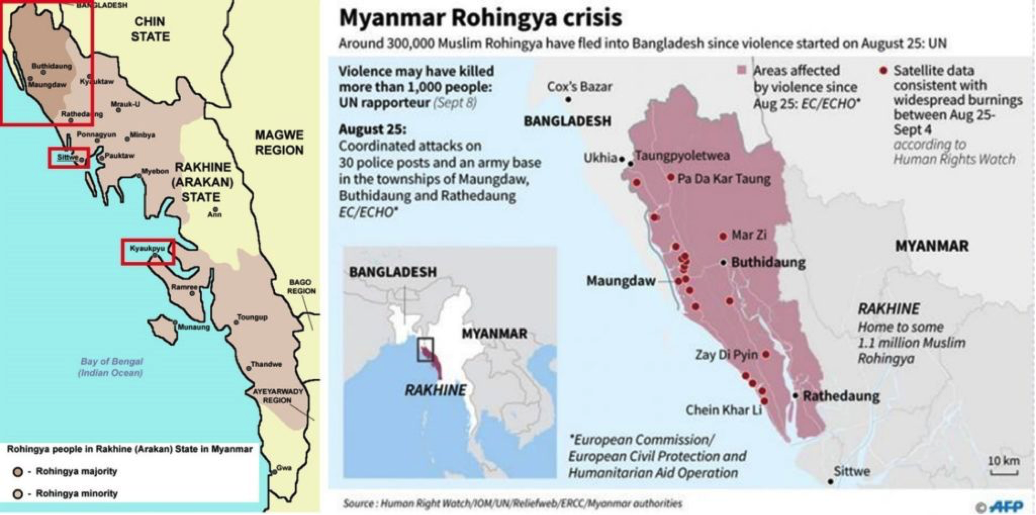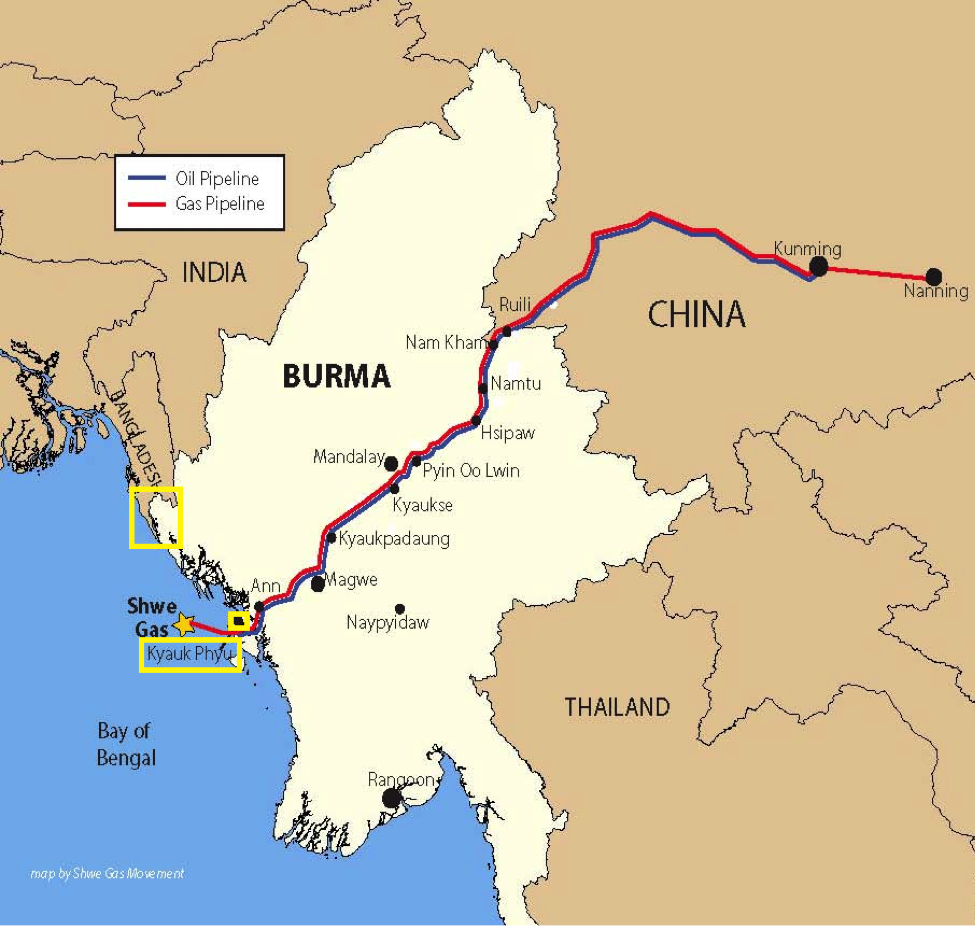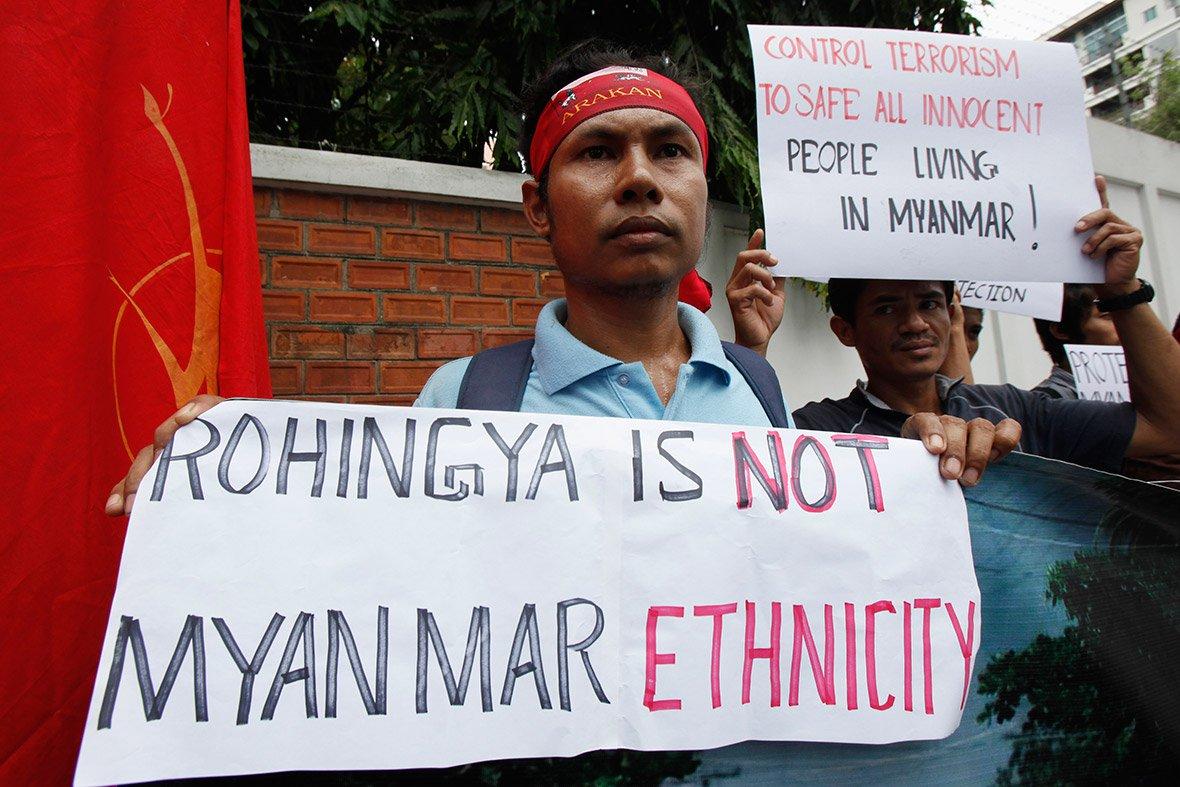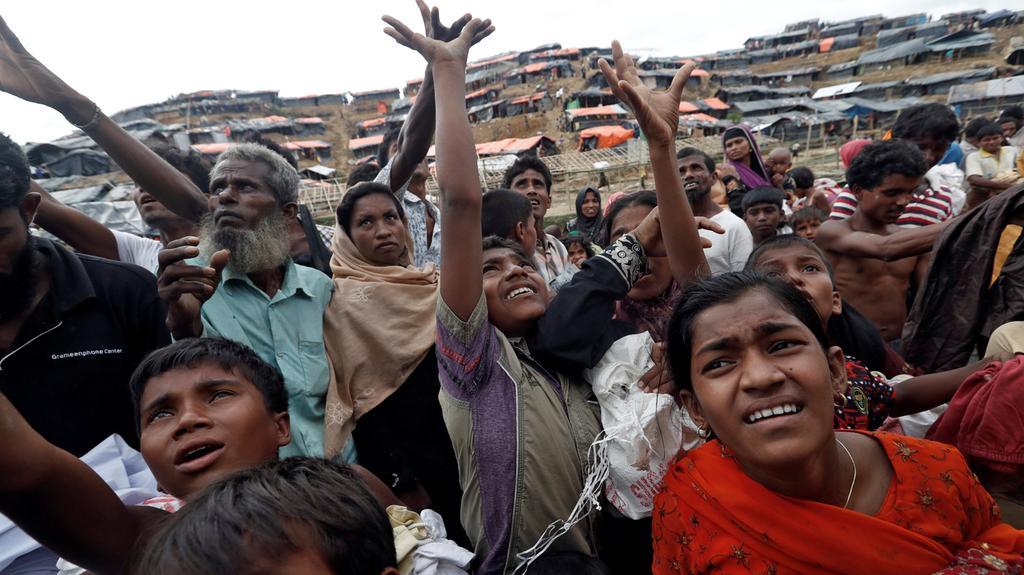Beyond “Land Grabs”: A Better Political Economy of the Rohingya Crisis
archive

Beyond “Land Grabs”: A Better Political Economy of the Rohingya Crisis
Led by the noted sociologist Saskia Sassen, some argue that Rohingyas have been displaced as part of a massive land grab by the military, which is only using religion as a “veil” for their greed.1 The evidence? The government’s designation of 1.27 million hectares of land in Rakhine state for agricultural development; the Chinese port and Special Economic Zone (SEZ) being constructed at Kyaukphyu; and an existing oil and gas pipeline running from Kyaukphyu to China.
In order to assess the validity of this analysis, it would be useful to consider the following maps. The first shows the Rohingya population, concentrated heavily in a few townships bordering Bangladesh. The second shows the latest forced displacement and burning of Rohingya villages, concentrated entirely in these townships. Rakhine’s far north has been depopulated of Rohingya, but the center and south have been relatively untouched by military violence this time around. (This should also give pause to those claiming the army’s goal is “genocide” – a judgement I reject.)

Maps 1 and 2, showing location of Rohingya settlements and sites of forced displacement
Now consider the location of the developments supposedly driving this forced displacement, in the third map (below). Kyaukphyu is in central Rakhine state, about 120km south of the affected area. How can land clearing there possibly explain ethnic cleansing in townships located so far away? Challenged on this, Sassen has offered no coherent response.2
It may have been more plausible to link the crisis to plans announced for a new “economic zone” at Maungdaw, center of the recent violence. This deserves investigation, despite being entirely overlooked in recent accounts. However, this is a very small, probably unviable project. Accordingly, this is not just a question of shifting explanatory weight to a different land grab. Attributing such complex events to “business interests” is crude and reductionist, explaining very little.

Map 3: locations of Rohingya affected areas and zones of economic development
Land grabs have certainly happened across Myanmar to facilitate various megaprojects, fuelling ethnic conflict. This is well documented by Kevin Woods, whose scholarship Sassen neglects.3 Furthermore, land grabs, including those for the Kyaukphyu pipelines and SEZ, have undoubtedly displaced both Rohingyas and Buddhist Rakhine, causing widespread resentment.
However, development-induced land grabs simply do not require vast ethnic cleansing that displaces half of a given population. Nor, crucially, can “business interests” explain why such violence is greeted indifferently or even enthusiastically by most of Myanmar’s population, even by victims of previous land grabs. Nor can it explain previous forced displacements in 1977 and 1992, decades before any of these megaprojects and their associated land grabs.
Political economy must avoid simplistic economic reductionism, focusing instead on the interaction between political and economic dynamics as part of ongoing social conflicts.4 These conflicts always include ideological components like religion, which is never simply a crude “veil” for pecuniary motives. As Marx noted, ideas become a material force when they grip the minds of the masses. So how have politico-economic conflict and ideology evolved to produce this outcome?
Buddhist–Muslim conflict over land and resources in what is now Rakhine state is longstanding, traceable to struggles between Muslim empires and Buddhist kingdoms from the fifteenth to eighteenth centuries. But British colonialism (1824-1948) sowed the most important seeds for the current crisis. Britain ruled Burma as part of the Indian Raj, enabling and encouraging vast Bengali migration to address labor shortages in Burma. The Muslim population of Rakhine state surged, with total immigration to Burma peaking at 480,000 in 1927, in a population of just 13 million. Indians acquired prominent positions in trade, finance, and landholding.
development-induced land grabs simply do not require vast ethnic cleansing that displaces half of a given population. Nor... can “business interests” explain why such violence is greeted indifferently or even enthusiastically by most of Myanmar’s population
In response, anti-colonial nationalism among the majority ethnic Bamar acquired a strongly racist, anti-Indian and anti-Muslim streak, which persists today. There were anti-Indian riots in 1931 and anti-Muslim riots in 1926 and 1938. The Buddhist Rakhine followed suit amid the Japanese invasion during World War II, launching pogroms against Muslim “interlopers” and forcing tens of thousands into British-held India. The British subsequently armed Rohingya volunteer forces against the Japanese, but these troops often raided Rakhine villages instead.
After WWII and Burma’s independence, Muslims in Rakhine continued to be depicted as aliens. As they returned from India, many were branded “illegal Bengali immigrants”—a trope persisting today. Some feared incorporation into a hostile, majority-Buddhist state, agitating for incorporation to Pakistan through a “Mujahit” rebellion. This prompted army counter-insurgency operations throughout the 1950s. Most Muslims, however, disavowed the rebellion, seeking Burmese citizenship. Since the new state was organized along ethnic lines, they felt compelled to pursue citizenship by articulating a “Rohingya” ethnic identity,5 a term little used before the 1950s.6 However, “Rohingyas” were never formally accepted as an indigenous ethnic group. But throughout Burma’s democratic period, they were courted politically, allowed to vote, and even elected to parliament.
Sadly, the racist, xenophobic, and exclusionary nature of Burmese nationalism intensified, particularly under military rule (1962-2011). Post-colonial governments were strongly committed to “Burmanisation” of the foreign-dominated economy. Land was quickly nationalized in the 1950s, followed by Indian-owned businesses in the 1970s, prompting the departure of some 300,000 ethnic Indians. The post-2011 “969” movement, promoting a boycott of Muslim businesses, is merely the latest expression of this xenophobic economic nationalism.

Burmese nationalist protester
Nationalists also channelled and stoked popular fears about threats to Buddhism. Under colonial rule, the influx of Muslim migrants and Christian missionaries, plus British neglect of the traditional duties of Buddhist kinship, fomented a sense of crisis. Restoring Buddhism became central to Bamar nationalism and steadily Bamar-Buddhist culture became hegemonic in post-colonial nation-building, marginalizing ethnic and religious minorities.7
Today, many Buddhists genuinely believe their culture is imperilled by a Muslim demographic time bomb, despite the fact that Muslims comprise just three percent of the population (Buddhists comprise 89 percent). There were anti-Muslim riots even under military rule, in 1997 and 2001, and in 2003 the firebrand monk Ashin Wirathu was jailed for inciting anti-Muslim violence. Wirathu re-emerged after 2011 to lead MaBaTha, the Association for the Protection of Race and Religion. Widespread support for MaBaTha, and discriminatory laws to “defend” Buddhism, reflects the widespread sense of siege.8
Buddhist–Muslim conflict over land and resources in what is now Rakhine state is longstanding… But British colonialism sowed the most important seeds for the current crisis.
Sadly, Aung San Suu Kyi has done virtually nothing to challenge these perceptions. Indeed, she has pandered to them by not running any Muslims as National League for Democracy candidates in the 2015 elections and, most recently, allowing her office to use the provocative term “Bengali.”
These intersecting material and ideological dynamics explain the recurrent persecution of the Rohingya, and anti-Muslim attacks more generally. As Bamar-Buddhist nationalism intensified, and struggles by minorities resisting forced homogenization mounted—precipitating the world’s longest running ethnic conflicts—the state became increasingly Islamophobic. Muslims were expelled from the army in 1962. In 1977, the army launched a crackdown against “illegal Bengali immigrants,” displacing 200,000 Rohingyas to Bangladesh. The 1982 Citizenship Act then stripped Rohingyas of their rights. Increasingly intolerable treatment prompted 250,000 Rohingyas to flee again to Bangladesh in 1992. In 2012, communal violence flared between the Rohingya and the Rakhine—who feel doubly “victimized” by “illegal Bengali immigration” and the army—leading to de facto martial law and worsening conditions for Rohingyas. ARSA’s formation was only a matter of time. But while its attacks may seek to liberate the Rohingyas, they have only provoked further army brutality and mass hostility.
Thus, the roots of today’s violence and forced displacement do not lie shallowly in short-term land grabs, but rather reside deeply in Myanmar’s political, social and economic fabric. Decades of bitter struggles over land, citizenship, and identity have produced deep insecurities and recurrent state violence. The root cause is a nation-building strategy based around exclusionary ethno-religious identities, which has systematically failed to win the consent of Myanmar’s ethnic minorities. Elsewhere in Myanmar, the army tries to forcibly incorporate minorities in its project. Yet the Rohingyas, unrecognized even as a national minority, face recurring cycles of persecution and forcible exclusion.

Aid distribution at Rohingya camp, Cox's Bazar, Bangladesh - September 18, 2017. Source: Reuters
1 Saskia Sassen, “Is Rohingya Persecution Caused by Business Interests Rather Than
Rohingya Is Not Only About Religion — It’s Also About Land”, Huffington Post,
15 September 2017; Giuseppe Forino, Jason von Meding and Thomas Johnson,
“Religion is Not the Only Reason Rohingyas are Being Forced Out of Myanmar”,
The Conversation, 12 September 2017.
2 See https://twitter.com/SaskiaSassen/status/913467249649995776.
3 For a selection of Woods’ work, see https://www.tni.org/en/search?f%5B0%5D=people%3A357.
4 See Garry Rodan et al. (eds.) The Political Economy of Southeast Asia: Markets,
5 See Nick Cheesman, “How in Myanmar ‘National Races’ Came to Surpass
2017: 461-483
6 See Derek Tonkin, “The R-word, and its Ramifications”, Democratic Voice of Burma,
7 Matthew J. Walton, “The Wages of ‘Burman-ness’: Ethnicity and Burman Privilege in
8 Matthew J. Walton and Susan Hayward, Contesting Buddhist Narratives:
East-West Center, 2014).



